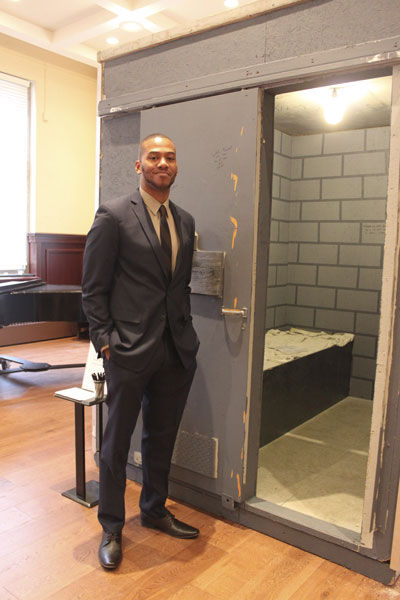By Lea Kahn, Staff Writer
The 6-foot-by-6-foot-by-8-foot wooden box stands in the middle of the meeting room at Pierce-Bishop Hall at Trinity Church on Mercer Street.
A single light bulb inside a metal cage illuminates the box, which does not have a window. It stays lighted, 24 hours a day.
A plywood plank serves as a bed, and a one-piece toilet and sink is the only sanitary facility. There is no shower stall.
This is just a replica of a solitary confinement cell, but former prison inmate Terrell A. Blount lived in a real solitary confinement cell at East Jersey State Prison — originally known as Rahway State Prison — for several months.
The Newark resident, who served five years of a six-year sentence for robbery in which he was the driver of the get-away car, spoke to parishioners about his experiences at a special forum Sunday morning. The forum was part of Trinity Church’s “Martin Luther King Jr. Weekend.”
The forum is part of Trinity Church’s “Sacred Conversation on Race,” begun by the Rev. Nancy J. Hagner, in the aftermath of the mass shooting at Emmanuel A.M.E. Church in Charleston, S.C. Parishioners spent eight weeks each studying the history and meaning of white supremacy, and discussing its roots in the history and theology of Christianity.
“We as a community are committed to addressing injustice in any way we can. It comes from our faith,” said Matthew Burdette, who is co-leading the congregation’s conversation on race with the Rev. Hagner.
“We believe human beings are made for humanity. Solitary confinement is simply torture. It is an attack on the very humanity of those who are locked away in isolation. We are shining a light on injustice, and we hope and pray it will open up a way for changes to be made,” he said.
Meanwhile, since his release from prison, Mr. Blount — a self-described “person in re-entry (into society)” from the prison system — has earned a bachelor’s degree from Rutgers University, and is studying for a master’s degree in public administration at Rutgers. He is a program coordinator for New Jersey Scholarship for Transformative Education in Prisons, which helps ex-prisoners earn two-year and four-year college degrees.
“When I first came in here (to the meeting room) and I walked inside (the replica solitary confinement cell), this is what it looks like. Gray paint, a toilet with a sink,” Mr. Blount said, marveling at the replica cell provided by the Trenton/Princeton chapters of the Campaign to End the New Jim Crow “Out the Box” initiative.
While solitary confinement is supposed to be used for short periods of time, it’s not true, Mr. Blount said. He knew a man who had been in solitary confinement for 20 years. The cells are intended to be used for the most dangerous prisoners, but that’s not true, either. Inmates can be confined for not taking their medication, for example.
In his case, Mr. Blount said, he was put in solitary confinement for possession of a weapon. It was not a “shank,” or prisoner-made knife, but a single razor blade that he was going to use to cut out photographs to send to his family and friends. It was in an envelope with photographs in his prison cell.
For that transgression, Mr. Blount was sent from the Garden State Youth Correctional Facility in Crosswicks to East Jersey State Prison, where he was placed in solitary confinement. Prisoners are allowed out of the cell for about an hour every day for exercise.
“On the bed, there was a blanket and a pillow with no pillow case. It had blood, dirt and thousands of germs on it,” Mr. Blount said. There was no soap in the cell, and “if you were asleep when meals were served (through a wooden slot in the door), you had to wait until the next meal,” he said.
Solitary confinement has psychological ramifications for the person who is subjected to it, Mr. Blount said. Erratic behavior, mood changes, yelling out loud are some of the results of being confined to a cell with virtually no human contact. He knows of former prisoners who have committed suicide.
“I sometimes wonder if I didn’t have the help and mentoring and support (from my family), where would I go? That’s why I struggle with (being known as) a solitary confinement survivor,” Mr. Blount said.
“Individuals such as yourselves, who show an interest in stopping the monster of solitary confinement — that’s what keeps me going. My students (at NJ-STEP) tell me they want to do what I do. That gives me hope,” Mr. Blount told the attendees.

